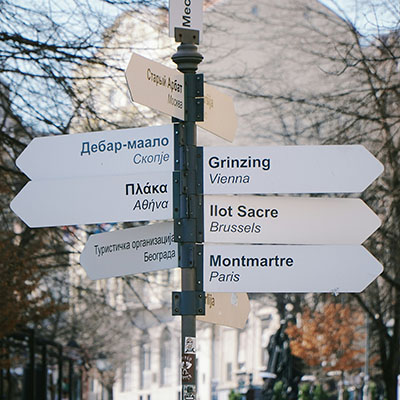10+ Non-English-Speaking Countries Where Locals Speak English
Travel Team | Jan 23, 2024

Traveling to non-English-speaking countries can be daunting. Over the years, when I recommend to people that they visit a particular country, they tend to get an uncomfortable look in their eyes.
“But,” they say nervously, “I don't speak Croatian."
“Don't worry,” I respond. “Most Croatians will speak English with you.”
If you’re fluent in English, then you are in luck when it comes to world travel. English can be one of the most useful languages to speak on the planet as it’s estimated that more than one billion people speak English as their primary or secondary language.
Even when English isn’t an official language in a particular country, there are good odds that you’ll find someone with at least a basic familiarity with the language. That's good news for anyone who wants to see more of the world, even if their language skills aren’t yet at expert levels.
It’s not an exhaustive list, but the non-English-speaking countries below are a great place to start your next adventure.
Non-English-Speaking Countries in Asia
Philippines
The Philippines are a collection of Southeast Asian islands where more than 100 languages are spoken. Two of those — Filipino and English — are official languages, and Tagalog is the most common dialect.
A 2023 survey found that while 93% of Filipinos understand spoken Filipino, 55% of Filipinos speak English. As is the case in many countries, if you stick to major cities and tourist centers, you’ll find more English speakers.
Go island hopping — Siargao is one of the post popular islands in the Philippines — see the Banaue Rice Terraces, and go hiking in the Mayon Volcano Natural Park. Citizens of many countries, including the United States, do not need visas when visiting the Philippines for less than 30 days, putting another tic in the pro column for visiting.
Singapore
Singapore is a uniquely bustling destination that is the crossroads of Asian culture. Still, don’t be so quick to put it on a list of non-English speaking countries. When communicating with each other, Singaporeans often use English as the common tongue. More than 48% of people in Singapore report speaking English frequently at home. That’s more than any other language.
Part of Singapore's uniqueness is that it is one of only three surviving city-states still in existence. It's also a favorite among travelers looking for eco-friendly destinations, accessible countries to visit, and prime spots to work remotely.
Vietnam
Vietnamese is, unsurprisingly, the official language of Vietnam, but English is the preferred second language in this country. Some estimates put the percentage of people who speak English in Vietnam at more than 50%. Most of those people are found in popular tourist areas and in the main cities like Hanoi and Ho Chi Minh.
You might also include Hoi An on your Vietnam itinerary. Time it with the lantern festival to see one of the city’s most iconic events. There’s at least one every month as the festival in the Old Town aligns with the 14th day of each lunar moon. Vietnam also has a notable coffee industry, especially in Buon Ma Thuot, although this does take you farther from the main urban centers, so you may find fewer English speakers in this area.
Maldives
The smallest Asian country, the Maldives is a group of coral islands in the Indian Ocean, nearly 400 miles from the nearest mainland. Despite that distance, it’s become a popular bucket list travel destination. As such, English is commonly spoken and understood in the Maldives.
Baa Atoll has a UNESCO Biosphere Reserve designation, so if you’re into scuba diving, this is one stop you won’t want to miss in the Maldives. There’s also loads of snorkeling, swimming, stand-up paddle boarding, and just about any other water activity you can think of.
Honorable mention
Hong Kong was a British colony for more than a century. Combine that with its status as a global financial hub and its draw for high-income tourism, and it’s not surprising that English is a common language in Hong Kong.
Malaysia is also a former British colony, and the English language is one aspect of that time that has hung around. It’s still taught in schools up until around the age of 16.
Non-English-Speaking Countries in Europe
Germany
Germany has one official language: German. Don't speak German? That's no problem — Kein problem! While Germany is one of the non-English speaking countries in Europe, more than two-thirds of its population speaks English. Some estimates put that at 20 million English-speaking Germans.
Looking for beers and bratwurst? Try Munich. How about museums, art, and history? Make Berlin part of your German itinerary. Both cities are great if you don’t speak German, as you’ll find plenty of English speakers able to help you out. If you’re ready to get out of the city and experience a bit of a fairy tale though, try Neuschwanstein Castle, said to inspire the Sleeping Beauty Castle at Disneyland in California.
The Netherlands
As another one of the non-English speaking countries in Europe, more than 90% of citizens in the Netherlands (also known as Holland) know the English language. This makes it a seamless country for international travelers to negotiate … and a difficult one if you’re trying to learn Dutch since locals are more than happy to chat in English. In fact, the EF English Proficiency Index from 2022 ranked the Netherlands first in the world for English fluency, and Amsterdam was the number one city globally.
Knowing that the Netherlands is an English-speaking country, you can now travel with confidence, taking in sites like Delft (home of the famous blue pottery) and Kinderdijk (one word: windmills). Museums like the Anne Frank House and Van Gogh Museum often make the top of the must-do list for travelers.
Greece
Next on the list of European countries that don’t speak English is Greece. Most people speak modern Greek, but about half the population names English as its first or second language. You’ll find even higher chances of finding English speakers in touristy areas and in hotels, restaurants, and other traveler hotspots.
Choosing which of those hotspots to visit might be the toughest decision you make. There are literal classics like the Acropolis and Parthenon. The isles are renowned for their beauty, all blue waters and white hillside buildings. And of course, the food makes any trip worth it.
Croatia
Between 2015-2016, Western Europe received very little increase in tourism traffic. That’s certainly changed in more recent years, and native English speakers are reaping the benefits. Most English-speaking Croatians are part of the younger generations or work in tourist destinations. That being said, anywhere from 60% to 80% of Croatia is believed to be at least conversational.
Split and Dubrovnik are where most tourists flock, especially in the summer. That’s for good reason as their location along the Adriatic Sea makes them prime spots for sun and fun. Go farther afield to Plitvice Lakes National Park in the north. The waterfalls, lakes, and hiking make it one of the most beautiful areas you’ll find in Croatia.
Honorable mention
The Nordic countries — Norway, Finland, Sweden, Iceland, and Denmark — each have their own official language, but they’re also a notoriously multilingual bunch. More often than not, they’ll have English in their repertoire.
Non-English-Speaking Countries in Africa
Morocco
Though Morocco is definitely on the list of non-English-speaking countries, with only 15% of the population being English speakers, this is a high percentage compared to other countries in the region. While located in Africa, Morocco also has attributes that showcase elements of European and Arabic culture, such as art, language, and heritage.
Most shopkeepers will use English when trying to communicate with you — likely because they’ll be trying to haggle a deal — as you explore the souqs of Fez and Marrakesh. If you’ve ever fallen in love with pictures of a mountainous city almost entirely tiled and painted in blue, you need to put Chefchaouen on your Morocco itinerary, too.
Ghana
English is the official language of Ghana, but only about 50% to 60% of the population speaks it as a primary language. That it’s still taught in schools is a holdover from British colonialism, which persisted until the 1950s. English is common among travelers to Ghana, too, as this West African nation is a stop for many in voluntourism.
Ghana has more than 300 miles of tropical coastline, so your trip won’t be short on beaches and surfing opportunities. Mole National Park is Ghana’s largest wildlife refuge, home to some of Africa’s unique wildlife, including elephants. And any trip to Ghana should include a tour at Cape Coast Castle. As one of the last stops for slaves on their way to the Americas, this fort can be a challenging place to visit but an important one for understanding the country’s history.
Non-English-Speaking Countries in Latin America
Belize
Belize is Central America’s only English-speaking country. But while English is the official and most commonly used language of Belize — almost 63% percent of Belizeans speak it — English isn’t the only language. You’ll likely hear a lot of Spanish, Creole, and Maya as well.
Two things come to mind for Belize: water and indigenous ruins. Belize is bordered to the east by the Caribbean, to the north by Mexico, and to the south and west by Guatemala, after all. Areas like Caye Caulker are renowned for their snorkeling and scuba diving where you’ll see countless fish in a rainbow of colors. To the south, on the mainland, is Belize City, a good jumping-off point for exploring ancient Mayan sites like Xunantunich.
Puerto Rico
For those wanting to experience Latin American culture without trying to remember all those words from Spanish class, try visiting Puerto Rico. Though it is technically one of the non-English speaking countries in Latin America, about half of the Puerto Rican population can speak English.
If you’re a U.S. citizen, visiting Puerto Rico has the added benefit of not requiring a passport. This makes it relatively simple to visit Old San Juan, which is so full of history, shopping, and good eats. You’ll have your pick of gorgeous beaches, but for a slightly different sight, add Mosquito Bay to your Puerto Rico itinerary. At night, bioluminescence gives the water a blue glow. Just be sure to avoid a trip to Puerto Rico during hurricane season, June through October usually, when storms are more common.
Honorable mention
Language-learning app Babbel says that about 6 million people in Argentina speak English. That’s about 13% of the population, making it the country in South America with the highest number of English speakers.
You’ll find some of the best eco hotels in the world in Costa Rica. With this reputation as a sustainable travel destination, a good number of Ticos, particularly those who work in hospitality, speak English.
How to Visit a Country Where Few People Speak English
Obviously, not all countries have a high percentage of English speakers (nor should they be required to). And even when you do visit a place that has a larger English-speaking population, be prepared to meet people who either can’t or won’t communicate with you in your own tongue.
“While I’ve found Switzerland to be one of the easiest places to travel without knowing the local language, I’ve still run into tight spots,” said Seven Corners writer-traveler Becky Hart. “For example, people in rural areas and bus drivers — those with less exposure to tourists or not as much language education — won't always know English. They’ve always been up for a game of charades and are quick to laugh with you as you literally dance around the words you need.”
Try the tips below for those times you want to be better prepared in countries that don’t speak English. They’re also great for when you want to take the extra step to demonstrating cultural sensitivity, attempting to communicate with residents in their own native tongue.
1. Learn a few basic phrases — and don’t be scared to use them.
A little bit of learning can take you a long way. Sayings such as “Hello,” “Yes,” “No,” “Excuse me,” “I would like …,” “Where is …?” and “Can you help me?” can assist you in finding your hotel, ordering dinner, and slipping through a packed space.
Language apps like Duolingo and free online courses such as Coursera can help you build a basic language knowledge base. You can also work with a tutor — online or in-person — to develop your pronunciation.
If you can’t commit to a course, watch some YouTube videos with native speakers instead. These generally go through the language “need-to-knows” in just a few minutes. You might also be able to watch shows with subtitles.
Using a new language can feel awkward, but don’t be scared to put your studies to the test. Attempting to say something in your new language to a friendly local will show you’re trying. And you’ll get a lot farther simply by trying than if you let yourself get frustrated because they don’t understand English.
Bonus tip: Instead of “restroom,” learn “toilet” instead, which is more widely recognized outside the U.S.
2. When in doubt, draw or act it out.
If words aren’t working, try acting or drawing what you’re trying to communicate. This can feel a little silly, but it works. For instance, if you’re trying to find a landmark, like the Eiffel Tower, try sketching it in a notebook, or if you’re searching for a bar, mime drinking a beverage. As long as you’re willing to get a little creative, this should help you find where you’re going.
Bonus tip: Do a little bit of research on body language and hand signals in the country you’re visiting. In some areas, like the Balkans, nodding your head means no and shaking it means yes. In Greece, the thumbs up is as rude as a middle finger is in the United States. This can lead to unnecessary confusion and unintended offensive interactions.
3. Find a trusted translator app.
One of the most popular translation apps is Google Translate, and it’s for good reason. The app can convert written text on menus, signs, and anywhere else. It also works offline, so you don’t have to worry about trying to find free Wi-Fi to read a warning sign.
Google Translate even works for spoken conversations thanks to a talk-to-text option that translates what someone is saying in real time. If you’re traveling somewhere like South Korea, which uses a character-based language, there’s an option to draw the characters and get a translation in-app. This could prove very convenient.
There are a lot of other travel apps that can help with translation. Whichever one you choose, remember that they’re rarely going to be 100% accurate. Slang and variations in dialect can sometimes throw these techy translators for a loop.
Bonus tip: Translation apps work best for written text versus a live conversation. It can be kind of awkward to shove a phone in someone’s face when they’re trying to take your drink order.
4. Have a plan for getting from point A to point B.
 From the moment you arrive at your destination, be certain you know how to transport yourself from place to place. When you’re in the airport, still dazed from the time change, this will help you avoid any enterprising strangers who may charge a higher fare to take you to your intended destination.
From the moment you arrive at your destination, be certain you know how to transport yourself from place to place. When you’re in the airport, still dazed from the time change, this will help you avoid any enterprising strangers who may charge a higher fare to take you to your intended destination.
Outside of the airport, make sure you understand how public transportation works or how and where to find a taxi. Understanding these basics can give you some confidence in navigating your temporary city, even if you don’t speak the local language.
Before you leave home, make a sheet that has the name and address of your hotel and other major landmarks you plan on visiting. This way, you’ll be able to show your taxi or bus driver exactly where you’re going instead of explaining it.
Bonus tip: Airports commonly have signs written in English directing you to public transportation options. And thanks to electronic ticket kiosks, it’s becoming more common to be able to buy a train or bus fare in English.
5. Use your GPS and get a paper map.
Your phone’s GPS is your best friend in a foreign city. If you decide to stop by a random spot during the day, this is the easiest way to make your way there.
Paper maps are also extremely useful navigation tools. Yes, using one of these is going to make you look super touristy, but it’s such a great tool, it’s worth it. If you’re looking for a friendly local to help direct you to a location, pointing to it on the map can bridge the communication gap.
Bonus tip: Download GPS maps before you leave or when you’re in an area with free Wi-Fi. Then, you’ll have your directions on- and offline.
6. Ask the right person for directions.
It’s a bit of a stereotype, but you can improve your odds of finding an English speaker by looking for a professionally dressed younger person. They may work in an office where the language of business is English. Another option is going into the nearest establishment like a hotel or restaurant where employees interact with tourists on a regular basis.
Because English is becoming the second language of choice in many places, look for budding speakers on college campuses and at bookstores.

Bonus tip: Even if you only speak English, try starting the conversation in the local language. Stutter your way through a few words and then ask — in their language — if they speak English. Most people will see this as a polite attempt and be more receptive to helping.
7. Make it guided.
Going on a guided vacation with a group itinerary is a great way to ease yourself into international travel. In a group, you’ll have the chance to explore a new area with the help of a guide who speaks the local language and truly knows the area. You’ll also have the chance to explore the city with a new group of international travelers and maybe even make a few friends.
If you don’t want to fully commit to a guided trip, try booking a group-led day tour instead. This will give you a taste of the group experience without a major monetary investment.
Bonus tip: Look for a tour company that uses local guides. Not only will they have insider information on the places you visit, but there’s a greater chance that your tourist dollars are going straight into the local economy rather than to some international corporation.
8. Ask a travel community.
An easy way to make yourself feel less anxious about going to a new location is by checking out online forums. See what others have to say about getting around without knowing the local language.
Reddit is a great place to start. Google subreddit and your destination (“Subreddit Paris”) and you’ll likely find a group of eager locals or friendly expats who would love to show you around or give advice. Facebook also has plenty of travel groups filled with people looking for and providing travel info.
9. Keep the right frame of mind.
No matter if you’re upset because you missed your flight or frustrated because you can’t find somewhere to buy water, be courteous when you chat with others. Try not to lose your head — that’s how you get into a dangerous situation. Take a deep breath and try to stay positive.
Part of traveling to new places is making mistakes and learning from them. So go out there with a bit of humility and an open mind, and you’ll have a great time.
If someone else traveled there and figured out a way around the language differences, you can do it, too. Afterward, you’ll feel great that you met a challenge head-on and succeeded!
Travel Assistance with Translation Services
Language barriers can make trips exceptionally fulfilling. It’s a great way to find out exactly what you’re capable of and lets you be more creative in how you approach challenges. But language barriers can also be exceptionally overwhelming if you find yourself in a true emergency.
For those times you get sick or hurt while traveling, make sure your travel insurance provider offers travel assistance services. With a team like Seven Corners Assist, you get experts who can act as translators between you and medical staff to make sure you get the care you need.
Learn more in our ultimate guide to travel insurance or talk to one of our licensed agents. They'll answer all your questions — big and small — before you strike out on your next adventure.
About the Authors
This blog was a team effort by several Seven Corners travel experts. Luke Armstrong provided his list of best non-English speaking countries to visit and still find English speakers. Kelsey Tharp Nighthawk contributed her favorite tips for traveling through countries where you don’t speak the local language. The article was edited by Becky Hart.
Search Posts
Receive our monthly inspiration and travel tips from the travel insurance experts.
Sign me upThis website and various social media updates provided by Seven Corners contain content, information, articles, videos, and links to websites created by third parties. Seven Corners, its owners, and its employees neither endorse nor are responsible for the accuracy, timeliness, or reliability of any third-party information, statements, opinions, or advice and are not liable for any loss, harm, or damage caused by your reliance upon them. Use of such information or the linked websites is entirely at your risk. Concerns regarding this third-party content should be directed to the third party. Seek professional advice, as appropriate, regarding your use of such information and websites.
Because the information on this website and in Seven Corners’ blogs and other social media is written and compiled using knowledge and information available at a certain point in time, it may become outdated. For that reason, information, events, legal requirements, and product changes (including benefits, limitations, exclusions, and services) may not be up-to-date, complete, or accurate at the point in time it is being read. Again, use of such information is at your risk.

